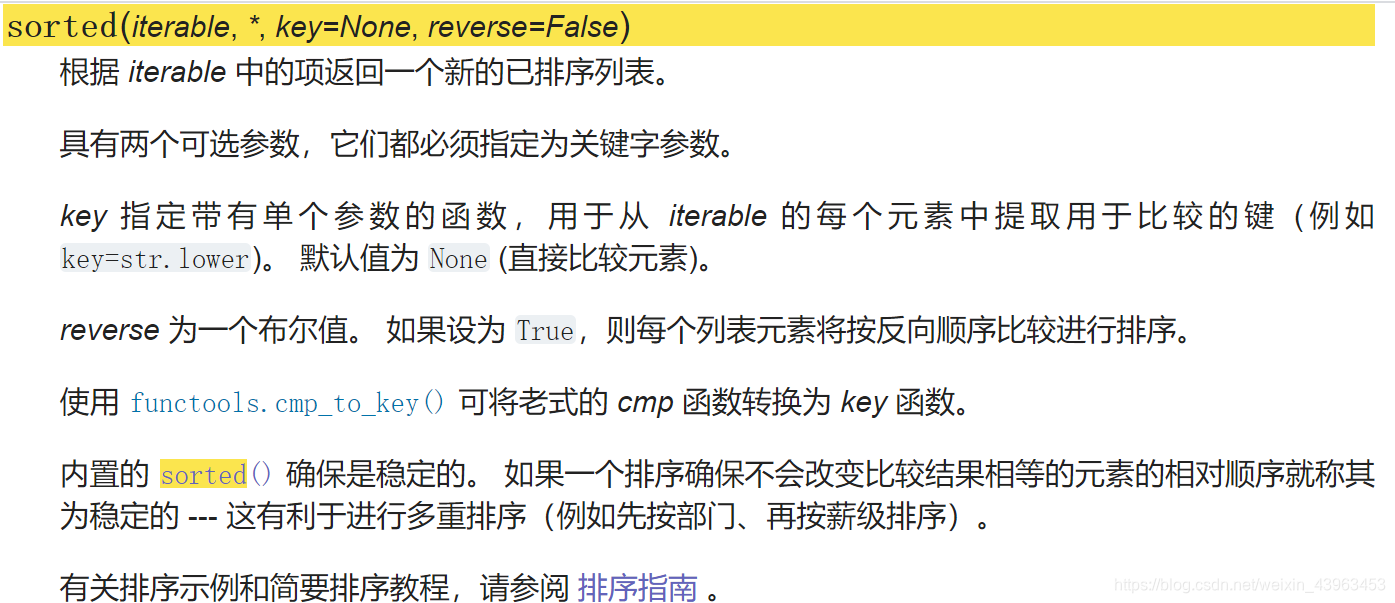库函数总结
- Python Build-in
- OS库
- np库
- torch
- torch.LongTensor()
- CLASS torch.utils.data.Dataset()
- CLASS torch.utils.data.DataLoader()
- CLASS torch.nn.Module
- Module.train(mode: bool = True) → T
- CLASS torch.nn.Linear
- CLASS torch.nn.ReLU(inplace: bool = False)
- CLASStorch.nn.Sequential(*args: Any)
- CLASS torch.nn.Conv2d()
- CLASS torch.nn.MaxPool2d()
- CLASS torch.nn.CrossEntropyLoss()
- CLASS torch.optim.Adam()
- torch.Tensor
- CLASS torch.no_grad()
- torchvision
- time
Python Build-in
sorted()
image_dir = sorted(os.listdir(path))
函数返回:

enumerate()
用于将一个可遍历的数据对象(如列表、元组或字符串)组合为一个索引序列,同时列出数据和数据下标,一般用在 for 循环当中。

for i, file in enumerate(image_dir):
str.split()
y[i] = int(file.split("_")[0])

str.format()
这个函数没彻底明白,暂且将遇到的总结一下:(因为格式太多了)
print("Size of training data = {}".format(len(train_x)))
object.getitem(self, key)

object.len(self)

object.call(self[, args…])

range 对象


open

OS库
os.listdir()
image_dir = sorted(os.listdir(path))

os.path.join()
img = cv2.imread(os.path.join(path, file))

np库
np.zeros()

x = np.zeros((len(image_dir), 128, 128, 3), dtype=np.uint8)
y = np.zeros((len(image_dir)), dtype=np.uint8)
np.argmax()
即:每行出一个还是每列

np. concatenate
def concatenate(arrays, axis=None, out=None):
"""
concatenate((a1, a2, ...), axis=0, out=None)
Join a sequence of arrays along an existing axis.
Parameters
----------
a1, a2, ... : sequence of array_like
The arrays must have the same shape, except in the dimension
corresponding to `axis` (the first, by default).
axis : int, optional
The axis along which the arrays will be joined. If axis is None,
arrays are flattened before use. Default is 0.
out : ndarray, optional
If provided, the destination to place the result. The shape must be
correct, matching that of what concatenate would have returned if no
out argument were specified.
Returns
-------
res : ndarray
The concatenated array.
See Also
--------
ma.concatenate : Concatenate function that preserves input masks.
array_split : Split an array into multiple sub-arrays of equal or
near-equal size.
split : Split array into a list of multiple sub-arrays of equal size.
hsplit : Split array into multiple sub-arrays horizontally (column wise)
vsplit : Split array into multiple sub-arrays vertically (row wise)
dsplit : Split array into multiple sub-arrays along the 3rd axis (depth).
stack : Stack a sequence of arrays along a new axis.
hstack : Stack arrays in sequence horizontally (column wise)
vstack : Stack arrays in sequence vertically (row wise)
dstack : Stack arrays in sequence depth wise (along third dimension)
block : Assemble arrays from blocks.
Notes
-----
When one or more of the arrays to be concatenated is a MaskedArray,
this function will return a MaskedArray object instead of an ndarray,
but the input masks are *not* preserved. In cases where a MaskedArray
is expected as input, use the ma.concatenate function from the masked
array module instead.
Examples
--------
>>> a = np.array([[1, 2], [3, 4]])
>>> b = np.array([[5, 6]])
>>> np.concatenate((a, b), axis=0)
array([[1, 2],
[3, 4],
[5, 6]])
>>> np.concatenate((a, b.T), axis=1)
array([[1, 2, 5],
[3, 4, 6]])
>>> np.concatenate((a, b), axis=None)
array([1, 2, 3, 4, 5, 6])
This function will not preserve masking of MaskedArray inputs.
>>> a = np.ma.arange(3)
>>> a[1] = np.ma.masked
>>> b = np.arange(2, 5)
>>> a
masked_array(data=[0, --, 2],
mask=[False, True, False],
fill_value=999999)
>>> b
array([2, 3, 4])
>>> np.concatenate([a, b])
masked_array(data=[0, 1, 2, 2, 3, 4],
mask=False,
fill_value=999999)
>>> np.ma.concatenate([a, b])
masked_array(data=[0, --, 2, 2, 3, 4],
mask=[False, True, False, False, False, False],
fill_value=999999)
"""
torch
torch.LongTensor()
CLASS torch.utils.data.Dataset()

CLASS torch.utils.data.DataLoader()


CLASS torch.nn.Module

Module.train(mode: bool = True) → T

CLASS torch.nn.Linear


eval() → T

CLASS torch.nn.ReLU(inplace: bool = False)

CLASStorch.nn.Sequential(*args: Any)

CLASS torch.nn.Conv2d()

CLASS torch.nn.MaxPool2d()


CLASS torch.nn.CrossEntropyLoss()

CLASS torch.optim.Adam()

Adam.zero_grad()

Adam.step()

torch.Tensor
Tensor.backward()

item() → number

CLASS torch.no_grad()

torchvision
torchvision.transforms
train_transform = transforms.Compose([
transforms.ToPILImage(),
transforms.RandomHorizontalFlip(), # 隨機將圖片水平翻轉
transforms.RandomRotation(15), # 隨機旋轉圖片
transforms.ToTensor(), # 將圖片轉成 Tensor,並把數值 normalize 到 [0,1] (data normalization)
])
time
time.time()























 544
544











 被折叠的 条评论
为什么被折叠?
被折叠的 条评论
为什么被折叠?








